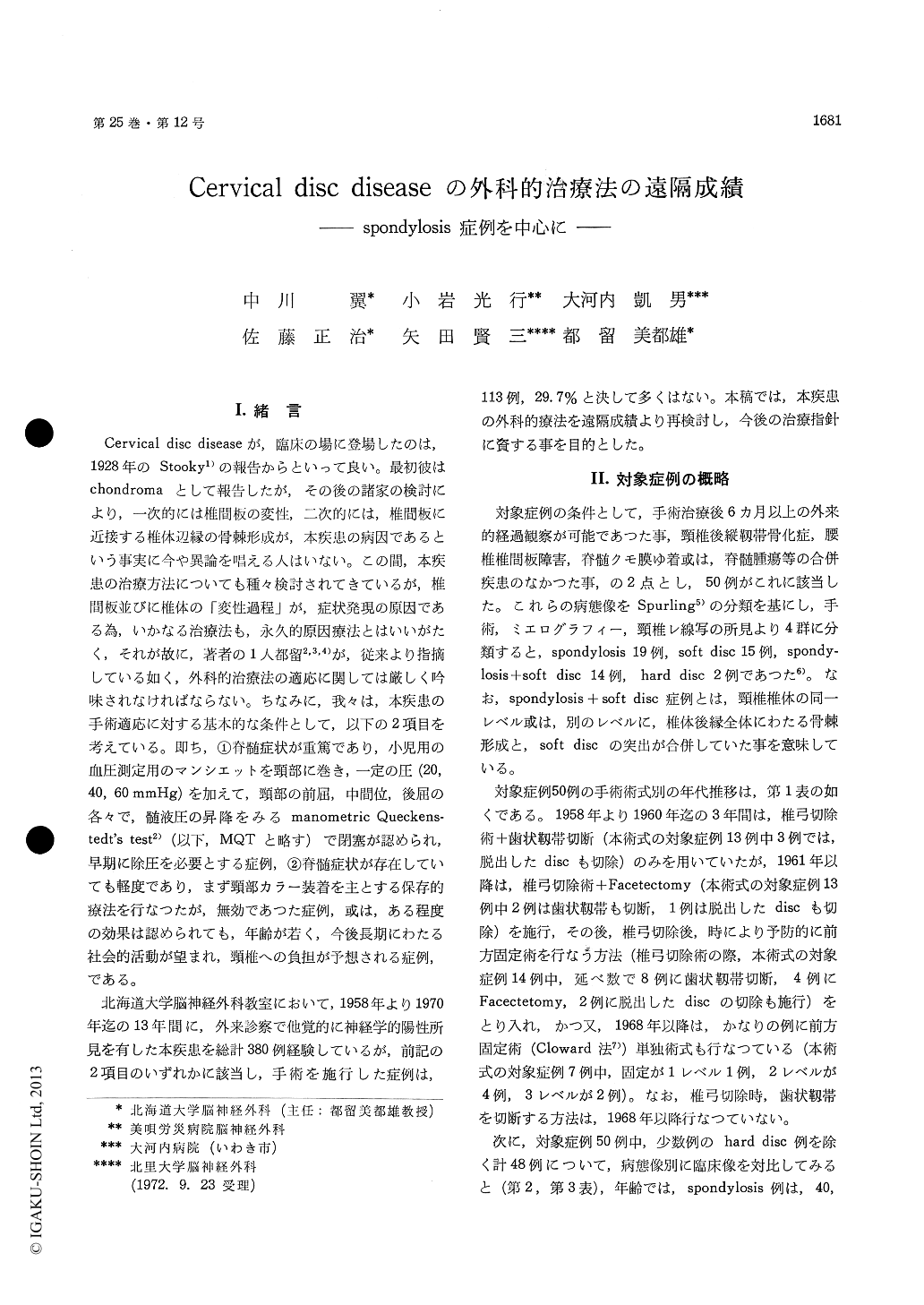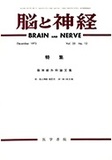Japanese
English
- 有料閲覧
- Abstract 文献概要
- 1ページ目 Look Inside
I.緒言
Cervical disc diseaseが,臨床の場に登場したのは,1928年のStooky1)の報告からといって良い。最初彼はchondromaとして報告したが,その後の諸家の検討により,一次的には椎間板の変性,二次的には,椎間板に近接する椎体辺縁の骨棘形成が,本疾患の病因であるという事実に今や異論を唱える人はいない。この間,本疾患の治療方法についても種々検討されてきているが,椎間板並びに椎体の「変性過程」が,症状発現の原因である為,いかなる治療法も,永久的原因療法とはいいがたく,それが故に,著者の1人都留2,3,4)が,従来より指摘している如く,外科的治療法の適応に関しては厳しく吟味されなければならない。ちなみに,我々は,本疾患の手術適応に対する基本的な条件として,以下の2項目を考えている。即ち,①脊髄症状が重篤であり,小児用の血圧測定用のマンシエットを頸部に巻き,一定の圧(20,40,60mmHg)を加えて,頸部の前屈,中間位,後屈の各々で,髄液圧の昇降をみるmanometric Queckens—tedt's test2)(以下,MQTと略す)で閉塞が認められ,早期に除圧を必要とする症例,②脊髄症状が存在していても軽度であり,まず頸部カラー装着を主とする保存的療法を行なつたが,無効であつた症例,或は,ある程度の効果は認められても,年齢が若く,今後長期にわたる社会的活動が望まれ,頸椎への負担が予想される症例,である。
北海道大学脳神経外科教室において,1958年より1970年迄の13年間に,外来診察で他覚的に神経学的陽性所見を有した本疾患を総計380例経験しているが,前記の2項目のいずれかに該当し,手術を施行した症例は,113例,29.7%と決して多くはない。本稿では,本疾患の外科的療法を遠隔成績より再検討し,今後の治療指針に資する事を目的とした。
During the past 13 years, the authors have experienced 380 cases of cervical disc disease with neurological manifestations. Surgical treatment was applied only to those of which symptoms have resisted to conservative treatment, those of which have shown block on manometric Queckenstedt's test, or those who required more stable neck.
During this period, a total of 113 cases wereconfronted to various operative treatments, including laminectomy with or without section of dentate ligaments, or foraminotomy, or removal of the disc material and fusion by anterior approach.
This report was made in an attempt to reevaluate effects of various surgical treatments by analyzing neurological signs and symptoms in relation to operative methods. Cases for the analysis were limited to those who had complete neurological and radiological follow-up for more than six months after surgery. This amounted to 50 cases. They consisted of 19 cases of spondylosis, 15 cases of soft disc, 14 cases of spondylosis combined with soft disc, and 2 cases of hard disc.
Among these 4 groups, the result of the surgical treatment was best in the cases of pure soft disc. In these cases regardless of type of operation applied, excellent result was obtained in 49% of the cases and good result in 40%. In contrast to this, in the cases of spondylosis, excellent result was obtained only in 4%, good result in 77% and in 19% of the cases no improvemeut was obtained. Therefore, in this report, the authors have made detailed analysis of the cases of pure cervical spondylosis. The results were as follows.
1. As to methods of operation :
In early years, laminectomy and section of dentate ligaments were performed to almost all of the cases. Although 75% of cases showed significant improvement of cord signs, 25% of the cases showed aggravation of root signs. Because of this fact, since 1961, foraminotomy was applied in combination with laminectomy in 10 cases. Since then, in no cases aggravation of root signs has developed following to surgery.
2. As to cord signs:
As mentioned before, in the cases of pure soft disc, recovery of cord signs was remarkable, following to decompressive operations. However, in the cases of pure spondylosis, improvement of cord signs was not so remarkable as in the cases of soft disc. In the cases of spondylosis, in most of the cases which showed block on manometric Queckenstedt's test improvement of cord signs was observed, after operation, while in 30% of the cases which showed no block, no improvement was obtained. This probably indicates that in the cases which showed no block on manometric Queckenstedt's test, affected site of spinal cord has already changed into localized atrophy before surgical decompression.

Copyright © 1973, Igaku-Shoin Ltd. All rights reserved.


